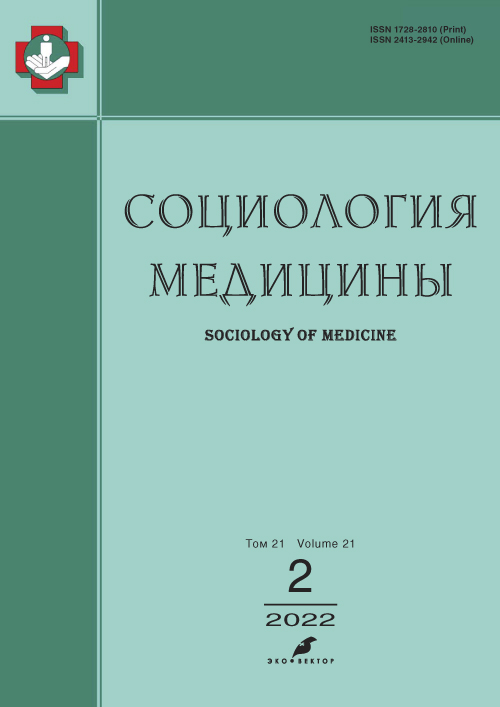Social portrait and features of the medical behavior of consumers of medical services in the Moscow region health system: A medico-sociological study
- 作者: Reshetnikov A.V.1, Sobolev K.E.2, Marochkina E.B.1
-
隶属关系:
- Sechenov First Moscow State Medical University (Sechenov University)
- Vladimirsky Moscow Regional Research Clinical Institute
- 期: 卷 21, 编号 2 (2022)
- 页面: 131-145
- 栏目: MEDICAL SOCIOLOGICAL STUDIES
- URL: https://rjsocmed.com/1728-2810/article/view/133673
- DOI: https://doi.org/10.17816/socm133673
- ID: 133673
如何引用文章
详细
BACKGROUND: The healthcare system is the most important social institution affecting the life of each member of Russian society. To improve the organization of the provision of medical care to citizens in the context of long-term program-oriented strategic planning for health development in the region, it is necessary to take into account the interests, expectations, and requests of patients (as consumers of medical services) regarding the quality of medical care, staffing, and the material, technical, and technological equipment of medical organizations.
AIM: Construction of a social portrait of consumers of medical services of the healthcare system of the Moscow region, taking into account the socio-demographic and socioeconomic characteristics of patients and the salient characteristics of their medical behavior.
MATERIALS AND METHODS: The study (a questionnaire survey of 531 patients) was conducted in February–May 2022 based on the Moscow Regional Research Clinical Institute named after M.F. Vladimirsky. The subject of the study was consumers of medical services at the institute at the age of ≥18 years, permanently residing in the Moscow region. The survey participants were recruited based on the calculated selective population, with quotas by sex and age. The thematic sections of the questionnaire focused on the study of the level of satisfaction of respondents with the medical services received, the characteristics of their medical behavior and attitudes to their health, and the analysis of the main socio-demographic characteristics of patients (gender, age, social and family status, education, and financial situation).
RESULTS: The study, conducted among residents of the Moscow region, made it possible to determine their attitude to their health, the level of satisfaction with the medical service received, features of medical behavior, and experience of interaction with medical workers (primarily doctors), including conflict situations. It has been established that among patients, a positive assessment of the quality of the medical services they receive prevails, most of them prefer to receive information about diseases, methods of treatment, and drugs from medical professionals, and they tend to trust doctors and comply with their prescriptions. When patients experience conflict situations, this most often happens with registry workers and is mainly due to the difficulty of getting an appointment with a doctor.
CONCLUSION: The study identified the most characteristic features of medical behavior and described a social portrait of a typical consumer of medical services in the Moscow region.
全文:
作者简介
Andrey Reshetnikov
Sechenov First Moscow State Medical University (Sechenov University)
编辑信件的主要联系方式.
Email: reshetnikov_a_v@staff.sechenov.ru
ORCID iD: 0000-0001-9413-4859
SPIN 代码: 6488-3251
MD, Dr. Sci. (Med.), Dr. Sci. (Soc.), professor, academician of the RAS
俄罗斯联邦, MoscowKonstantin Sobolev
Vladimirsky Moscow Regional Research Clinical Institute
Email: Sob-kos@live.ru
ORCID iD: 0000-0003-4779-8577
MD, Cand. Sci. (Med.)
俄罗斯联邦, MoscowElena Marochkina
Sechenov First Moscow State Medical University (Sechenov University)
Email: marochkina_e_b@staff.sechenov.ru
ORCID iD: 0000-0002-3402-2326
SPIN 代码: 6340-7940
MD, Cand. Sci. (Med.), department professor
俄罗斯联邦, Moscow参考
- Reshetnikov AV, Sobolev RE. Mediko-sotsiologicheskii monitoring: Pukovodstvo. Мoscow: GEOTAR-Media; 2022. (In Russ).
- Reshetnikov AV, Khudoshin NA, Yakimov VN, et al. The prognostic value of some risk factors on the quality of life in patients total hip arthroplasty. Medical News of the North Caucasus. 2022;17(3):277–280. (In Russ). doi: 10.14300/mnnc.2022.17067
- Reshetnikov AV. Sociology of Medicine. Moscow: GEOTAR-Media; 2022. (In Russ).
- Grishina NK. The basic principles of the implementation of sociological monitoring programs in public health. Problems of social hygiene, public health and history of medicine, Russian journal. 2011;(2):32–36. (In Russ).
- Krom IL, Yerugina MV, Eremina MG, et al. Modern transformations of medicine space from medical care to a medical service. Bioethics. 2019;(1):27–29. (In Russ). doi: 10.19163/2070-1586-2019-1(23)-27-29
- Pokida AN, Zybunovskaya NV. Health in the perception of Russians and real medical practices. Public health and life environment — PH&LE. 2021;29(7):19–27. (In Russ). doi: 10.35627/2219-5238/2021-29-7-19-27
- Kozyreva PM, Smirnov AI. Russian Citizens’ Health Self-assessment Dynamics: Relevant Trends of the Post-Soviet Era. Sociological Studies. 2020;(4):70–81. (In Russ). doi: 10.35627/2219-5238/2021-29-7-19-27
- Schetinina SYu. Medical activity as a component of a healthy lifestyle. International journal of humanities and natural sciences. 2020;(5–3):194–197. (In Russ). doi: 10.24411/2500-1000-2020-10581
- Konovalov OE, Allenov AM, Gorenkov RV, et al. The priority directions of forming and supporting healthy life-style in megalopolis conditions. Problems of social hygiene, public health and history of medicine, Russian journal. 2021;29(3):421–425. (In Russ). doi: 10.32687/0869-866X-2021-29-3-421-425
- Martynenko TS. Lifestyle diseases: health in the contemporary city. RUDN Journal of Sociology. 2021;21(1):18–35. (In Russ). doi: 10.22363/2313-2272-2021-21-1-18-35
- Gubachev NN, Korshunov AM, Titov VN. Issues of popularization of medical knowledge for health promotion and healthy lifestyle through mass media. Problems of social hygiene, public health and history of medicine, Russian journal. 2020;28(S):711–715. (In Russ). doi: 10.32687/0869-866X-2020-28-s1-711-715
补充文件
















